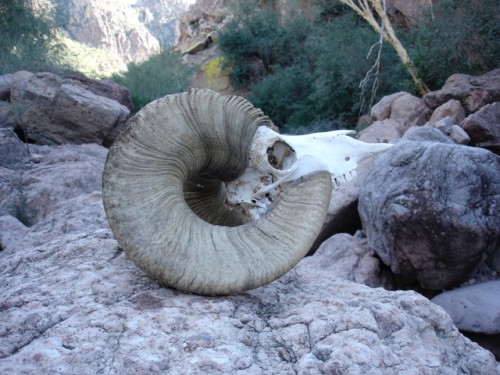 In the spring of 2012, botanist and graduate student Benjamin Wilder was camping on Tiburón Island, a large island in the Gulf of California whose flora he has studied for most of a decade.
In the spring of 2012, botanist and graduate student Benjamin Wilder was camping on Tiburón Island, a large island in the Gulf of California whose flora he has studied for most of a decade.
Wilder wanted to find out more about the evolutionary history of the plants on Tiburón, so he was looking for fossil woodrat middens—piles of vegetation and other debris collected by woodrats, glued together with woodrat pee, and cached away for tens of thousands of years. For scientists, woodrat middens are like care packages from the past.
In a shallow cave in the foothills of the Sierra Kunkaak, Wilder, a lab mate, and two friends from the local Seri community found something that resembled a midden, but didn’t look quite right: It had a lot of dung in it, and not many plants. Wilder took it back to Tucson, Arizona, and showed it to his mentor Julio Betancourt, who recognized it with a look and a sniff. “That’s bighorn sheep dung,” he said. Its identity was confirmed by DNA analysis, and when samples were radiocarbon dated, they turned out to be 1,500 years old.
Which was, as far as anyone knew, impossible.
The Seri people, who have lived on Tiburón Island and the nearby Sonoran coast for at least 2,000 years, have a story. They say that Orion’s belt, which they call Hapj, consists of three stars: one for the mule deer, one for the pronghorn, and one for the bighorn sheep. When the great hunter of the sky, Azoj Cmiique, shot his arrow at the stars, it struck the mule-deer star, and some of the blood from it dripped on Tiburón (the rest of the blood, they say, remained in the sky as Betelgeuse). And so for thousands of years, the Seri say, there were no bighorn sheep on Tiburón. There were no stories about them, no memories of them, no evidence of them.
But in 1975, bighorn sheep did come to Tiburón. A binational effort introduced 16 female and four male bighorns to the island, and the population thrived, rapidly multiplying to 500 animals. Today, trophy-hunting tags on Tiburón fetch up to $90,000, and most of the revenue goes to the Seri, some of whom work as hunting guides. The program was and remains controversial in conservation circles, however, because it involved the introduction of a non-native species. Or, at least, the introduction of a species that everyone—even the Seri—believed to be non-native.
So what now? In a paper published this week in PLoS One, Wilder and his colleagues call the situation an “unintentional rewilding.” What looked like an introduction of an exotic species turns out to have been an accidental restoration. While the bighorn’s ancestral roots on Tiburón may soothe some conservationists’ consciences, Wilder points out that modern wildlife managers aren’t off the hook: Ancient bighorn probably had some natural predators, but today’s bighorn have few predators aside from human hunters, and they create paths on the island so large that locals describe them as “sheep highways.”
A lot can change in 1,500 years, and a lot can be forgotten. But sometimes, it can be rediscovered in an instant.
Photo of a bighorn sheep skull on Tiburón Island courtesy of Benjamin Wilder.
One thought on “The Long Now of the Tiburón Bighorn”
Comments are closed.